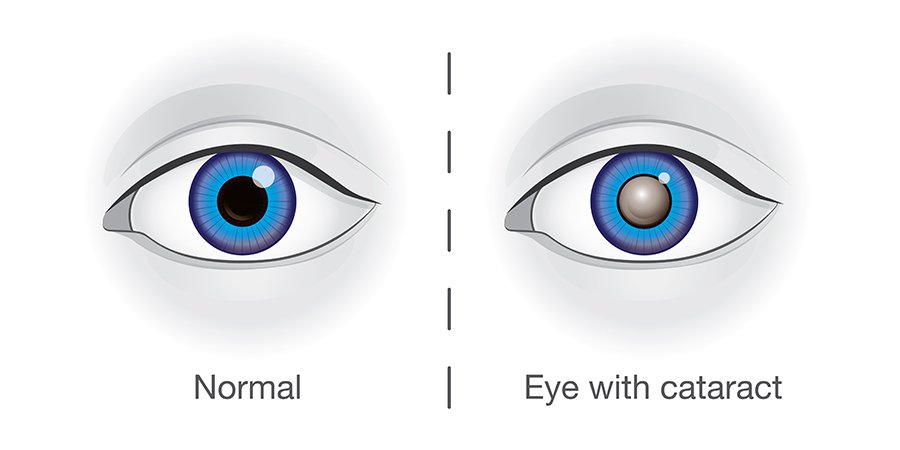How are Cataracts Diagnosed?
If you are in your 60s and 70s, there is a chance you may have an eye condition known as “cataracts.” Are you currently experiencing problems with your eyesight? Have you noticed that your vision has been fading within the last few years?
What are the Symptoms of Cataracts?
It is possible the condition cataracts may affect your eyes. Symptoms include:
- Blurred or cloudy vision
- Muted colors
- Lack of definition
- Glare or the appearance of halos around light sources
- Inhibited night vision
- Double vision
- A marked degradation in your visual prescription over time (for eyeglass users)

How Common are Cataracts?
While cataracts are not uncommon – 21 million people in the U.S. alone have the diagnosis – it is very important to seek treatment as soon as possible. Cataracts can develop in either one or both eyes and negatively impact your quality of life. We at SightMD don’t want to scare you, but cataracts are a leading cause of blindness. The good news is that if diagnosed early enough, our doctors can slow the progression of your case of cataracts delaying surgery for as long as possible.
What to Expect at Your Cataracts Eye Appointment?
There are several techniques that doctors utilize for cataracts diagnosis. A cataract exam may need a combination of tests to gauge not only if you have cataracts, but the severity of the cataracts. Doctors may use further testing beyond these to determine what type of cataract you have. At our many office locations, we can check your vision and determine whether you have a cataract. If so, we will determine the best course of action to reduce your symptoms and treat the condition.
How are Cataracts Tested?
Cataracts diagnosis typically consists of:
- Visual Acuity Test – A standard visual acuity test will give us an indication of your vision quality. If you perform poorly, that doesn’t unto itself indicate that you have a cataract. Any number of vision impairments, such as nearsightedness, farsightedness, or astigmatism, can result in poor visual acuity. Poor results will indicate that vision treatment is necessary.
- Dilated Eye Exam – In this test, doctors administer eye drops to widen or dilate the eye pupils. Once dilated, doctors use a special optical lens to examine the retina and optic nerve. We can also look for visual signs of a cataract. The eyes will remain dilated for several hours after treatment, and you need to wear tinted lenses to protect your eyes from light.
- Tonometry – With this instrument, the pressure inside the eye is measured. High pressure in the eye can be a contributing factor to the formation of a cataract. Detecting such pressures can help us alleviate or eliminate contributing factors.
- Slit-Lamp Test – This test involves using a specialized microscope to look at the structures in the front of your eye. This microscope uses a narrow line of light to examine your cornea (outer eye layer), iris (colored part of your eye), the space between your cornea and iris, and your lens. The thin, strong line of light lets your doctor view small sections of these structures at a time, making it easier to spot any troublesome abnormalities.
Early detection allows us to provide early treatment. If you are suffering from blurred or cloudy vision, please don’t hesitate to seek treatment. Our ophthalmologists can diagnose a cataract during a routine eye exam making it very important to keep up to date with yearly appointments. First, your doctor may ask you about your symptoms and any recent changes in your vision. To detect a cataract, your ophthalmologist puts eye drops into your eye to dilate, or widen, the pupil. This allows your doctor to clearly view the lens of the eye and the retina. If your doctor finds a cataract they take into consideration its size, your age, and your overall health. This allows them to determine if treating the cataract with surgery might be the right option for you.
What Preventative Steps You Can Take to Avoid Cataracts?
There is no definitive way to prevent a cataract. However, experts believe it is crucial to prevent eye damage caused by ultraviolet radiation, which may increase the risk of eye problems occurring as you age. You should make it a point to wear sunglasses or a wide-brimmed hat wherever you go outside. If you are a smoker, now is the time to stop. Also, are you eating a healthy, balanced diet that’s rich in vegetables and fruits? These are all steps that can help slow the possible development of cataracts.
What if Cataract Surgery is Necessary?
We mentioned how an early diagnosis of cataracts could offset needing surgery to correct the condition. In some cases, however, the diagnosis may be too late, or the cataracts have developed at a faster rate. If your doctor determines that surgery is necessary with your diagnosis of cataracts, please know that SightMD provides the best possible care. Our highly qualified surgeons and efficient medical staff work with the latest state-of-the-art technologies, ensuring your operation will be safe, sound, and secure. After cataract surgery at SightMD, some patients have discovered improvement in their vision. Some even are at the point where they no longer need glasses to drive, look at a computer, or read books! So, cataract surgery – if necessary – can have added benefits.
Contact SightMD today to schedule an appointment with one of our doctors to discuss your vision health at one of our convenient locations!

Healthy Diet and Cataracts
The Role of a Healthy Diet in Preventing Cataracts As we age, various eye conditions can develop that impact…

Benefits of Cochlear Implants
Understanding the Benefits of Cochlear Implants Hearing loss can significantly impact one’s quality of life, making communication and connection…

Long-Term Considerations for Individuals with Cataracts
What to consider Long-Term for Individuals with Cataracts As we age, our eyes undergo various changes, and one common…